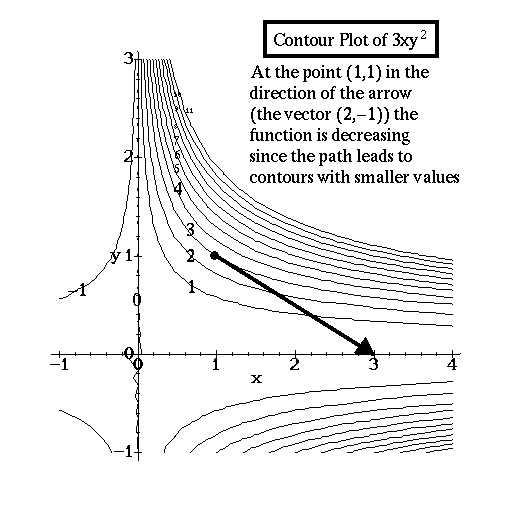Now, ![]() and
and ![]() tell us how rapidly the function
f(x,y) changes in the x and y directions. But suppose we don't want
to be restricted to just moving in the x and y directions. For
example, if the function f(x,y) represents the density of oil in an oil
spill, and we are sitting in a boat in the center trying to clean the
spill, we want to move toward the greatest concentration of oil. This might
not be along the x or y axis. We could get there more rapidly if we
knew how to compute the rate of change of the function in an arbitrary
direction.
tell us how rapidly the function
f(x,y) changes in the x and y directions. But suppose we don't want
to be restricted to just moving in the x and y directions. For
example, if the function f(x,y) represents the density of oil in an oil
spill, and we are sitting in a boat in the center trying to clean the
spill, we want to move toward the greatest concentration of oil. This might
not be along the x or y axis. We could get there more rapidly if we
knew how to compute the rate of change of the function in an arbitrary
direction.
Thus, if we sit at the point (x0,y0) and move along the unit vector
![]() how rapidly does the concentration
(ie. the value of f(x,y)) change? Clearly, if
how rapidly does the concentration
(ie. the value of f(x,y)) change? Clearly, if ![]() (ie. u1 = 1, u2 = 0) then the rate of change is
(ie. u1 = 1, u2 = 0) then the rate of change is ![]() since we
are moving in the x direction. Also clear is that if
since we
are moving in the x direction. Also clear is that if ![]() then the rate of change is
then the rate of change is ![]() . What if we don't choose one of
these special values though?
. What if we don't choose one of
these special values though?
The directional derivative of f(x,y) in the direction of the
unit vector ![]() is
is
![]()
Note that the directional derivative relies on a vector to give a
direction, but is itself a scalar quantity. All it tells us is how rapidly
the function changes in the ![]() direction. This is the reason for
the notation
direction. This is the reason for
the notation ![]() : to emphasize the similarity between the direction
derivative and the partial derivatives fx and fy. If we think of the
quantity as a dot product
: to emphasize the similarity between the direction
derivative and the partial derivatives fx and fy. If we think of the
quantity as a dot product
![]()
As an example, suppose we want to know the rate of change of f(x,y) = 3xy2 at the point (1,1) in the direction of the point (3,0).
